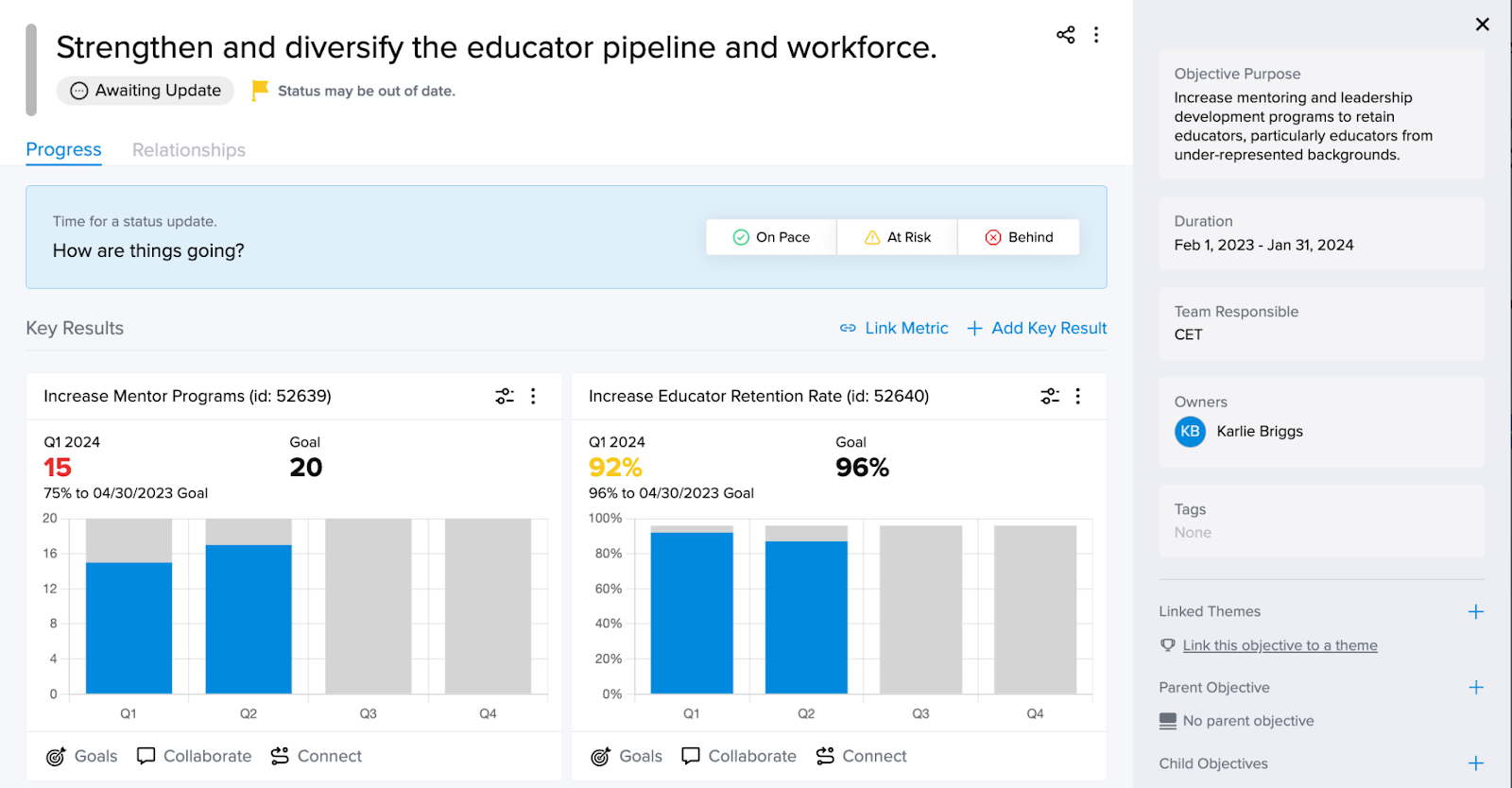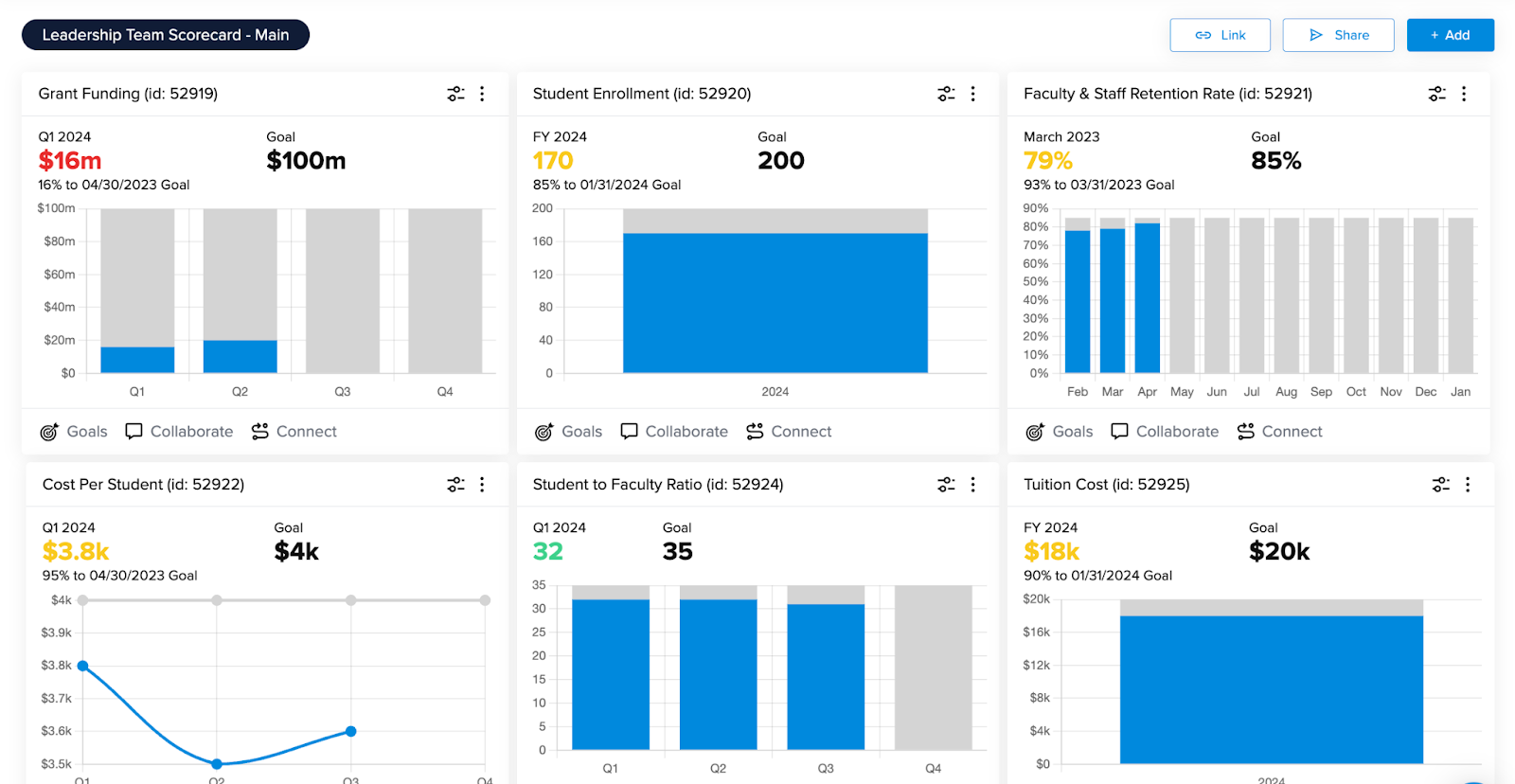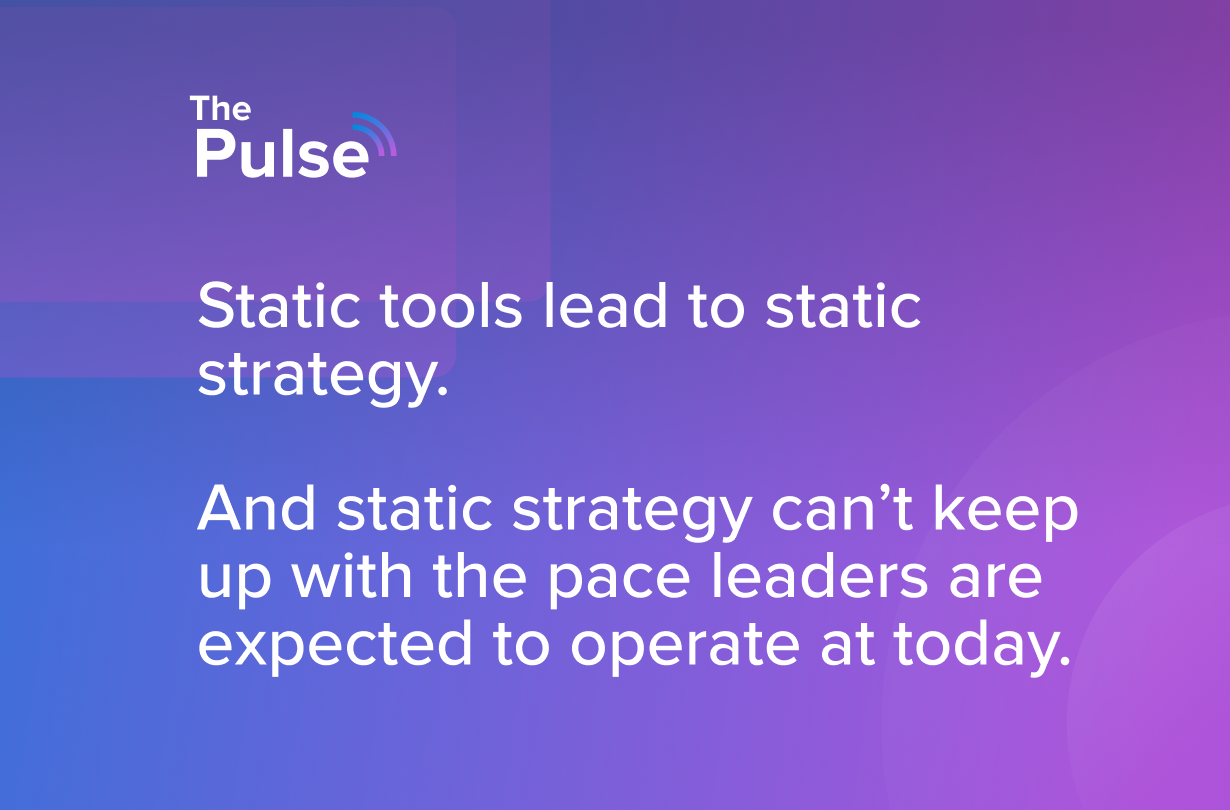
In education, evolution and adaptation are constants. Academic institutions must stay up to date with technology and teaching methods to succeed, while also managing students' social, emotional, and academic needs. With all of these considerations in addition to budgetary constraints, It's easy to see why ensuring student and institutional success requires a dynamic strategic plan.
This blog post will outline the best practices academic institutions should consider when developing an effective strategic plan to address these challenges. To create an effective strategic plan, we need to eliminate the disconnect between leadership's high-level vision and employees' tactical work. Leading academic institutions, growing companies, and organizations adapt to change through dynamic strategic planning.
A dynamic strategic plan breaks down an organization's long-term vision into short-term goals and then builds a roadmap to achieve those goals. As part of this process, the organization's plan should be reviewed and revised regularly to ensure relevance and alignment with its mission. Academic plans are typically written as multi-year plans and organizations often face challenges in developing effective strategic plans that are easy to understand and execute. Here are a few suggestions to help address these challenges:
- Clearly define your vision: The first step in developing an effective strategic plan is to define the vision for the school. This should be a clear, concise statement that articulates what the school hopes to achieve.
- Identify key objectives: Once you have a clear vision, identify the key objectives that will help you achieve them. These should be specific and measurable goals that align with your vision.
- Create measurable, outcome-focused key results: With your objectives in mind, it is important to focus on creating key results that drive outcomes, not outputs to help you reach your targets. Schools that focus on driving actionable objectives with outcome-based key results will ensure they stay aligned on what truly matters.
- Prioritize and allocate resources: It's essential to prioritize your strategies and allocate resources accordingly. Determine which strategies are most critical to achieving your objectives and ensure that you have the resources (e.g., time, budget, personnel) to implement them effectively.
- Monitor and evaluate progress: Finally, monitor and evaluate progress regularly to ensure that you are on track to achieving your objectives. This will help you identify areas where you may need to adjust your strategies or allocate additional resources.
By following these steps, academic institutions can develop a strategic planning framework and process that is effective, simple, and links vision to tactical execution. So now that we have the steps needed to build our strategy, let's start to bring it to life.
Take a field trip: host an annual Strategic Planning Offsite
Before each academic year, we recommend holding a strategic planning meeting offsite with your leadership team. This is dedicated time to focus on the priorities for the upcoming year. Before diving into where you're headed, set aside time for a retrospective to discuss the previous year. In addition, discuss the current education landscape.
To build a future-focused and tailored plan for your academic institution, the team should reconfirm your mission and values, set your vision, and define your top strategic priorities.
As you head into your offsite, we recommend the following best practices that lead to success:
- Get Outside of the Office: Find space outside of the work environment to reduce distractions and encourage collaboration.
- Set a Clear Agenda: Agree ahead of time on the purpose of each day, the deliverables, and actionable next steps.
- Make Space to Think: Carve out time for free thinking vs. relying on group thinking to encourage new ideas. If you need a template, we recommend using this worksheet to guide the conversation.
Simplify the strategic plan: align your high-level strategy with tactical execution
Academic plans are typically written as multi-year plans (5-year plans are most common) which can lead to a very detailed and dense plan. Given the complexity and length of the strategic plan, it can feel overwhelming and difficult to break the plan down and prioritize what’s most imperative to execute and focus on. We recommend breaking the larger multi-year plan into digestible annual plans that are more manageable.
We recommend identifying 3-5 main themes in your strategic plan, often referred to as pillars or rallying cries. Once you have core themes, you can prioritize and bucket the most critical initiatives and objectives. Every theme will have specific supporting objectives and key results. We recommend using consistent nomenclature when creating themes, objectives, and key results so any team member can easily understand why the work is significant.
Once we have the multi-year plan broken into annual plans and themes identified, we recommend defining short-term objectives (quarterly or semi-annually) and measurable metrics to drive key results. Breaking down the plan into quarters will feel more approachable and attainable. In addition, it will provide clarity and transparency for the executing team. When the strategic plan is broken down into actionable items, small wins can be celebrated along the way. This boosts motivation, engagement, and morale.

Consistency is key to a successful strategic plan
When individuals understand how their work aligns with the high-level strategy and vision, they can prioritize their initiatives. Establish clear, measurable objectives and key results that are easy to track and provide consistent nomenclature. Keep these three tips in mind when writing your strategic plan objectives:
- Objectives should be aspirational and push people outside their comfort zone.
- Each objective should have 2-3 measurable and quantifiable results.
- Have a clear, defined owner responsible for recurring status updates.
The best way to write objectives is to start by asking, “Why is this initiative important?” When you understand the why, you can create measurable outcome-driven results. Let’s walk through an example objective with key results laid out in Elate.

Theme: Develop and retain a diverse educator workforce.
Objective: Strengthen and diversify the educator pipeline and workforce.
Objective Purpose Statement: Increase mentoring and leadership development programs to retain educators, particularly educators from under-represented backgrounds.
Key metrics:
- Increase mentoring program engagement by 50%
- 96% educator retention rate
Implement rituals and track success with dynamic strategic planning
After your plan is built, it is imperative to establish rituals to stay on track and measure progress against the strategic plan. Rituals are defined as a rhythm, cadence, and process for reviewing objectives and strategic plans. Establishing strong rituals allows critical conversations to happen proactively. When objectives are stuck in limbo or fall off track, proactive discussions can happen. However, many academic institutions have different rituals for different teams. Implementing consistent rituals regularly will help you stay aligned, measure progress, and ensure you’re having the right conversations at the right time.

To keep everyone on the same page and connect tactical execution to strategic vision, we recommend objective owners provide bi-weekly updates. Across many academic institutions, strategy, and operations leaders spend countless hours tracking down updates that become outdated quickly. With Elate, reminder notifications are automatically sent to team members so they can focus more on execution and less on chasing down updates.

We recommend spending a few minutes in executive team meetings reviewing objectives that are off-track or not making progress to create an action plan moving forward. This ritual of reviewing the plan early often brings awareness to the leadership team about objectives that need attention or are falling behind. It also allows space to celebrate accomplishments and wins.
This makes it easy to ensure the strategic plan lives and breathes. Setting and clearly defining rituals for how the plan progresses, updates are made and reviewed, and addressing red flags is key to success.
Focus on the right metrics to measure your strategic plan's success

With key results, objectives, and business-as-usual metrics all in one place, Elate keeps the strategic plan organized with a consolidated view. In Elate, scorecards provide an essential view of business-as-usual metrics and progress. Create specific scorecards for the board, enrollment, grant, and donor activity.
Elevate your strategic plan with Elate
Strategic planning is critical for academic institutions that want to stay competitive, adapt to change, and achieve their goals. By following these best practices, higher education and academic institutions can achieve their goals and stay competitive in an ever-changing environment.
Strategic planning has never been easier with Elate. Our platform simplifies and streamlines the strategic planning process, taking the stress out of it. We make it easy to stay on track with transparent reporting, simple collaboration, and one-click integrations with Salesforce, Google Sheets, Microsoft Teams, and Slack. Your vision can finally meet your strategy.
Learn more about our strategic planning tools and services, or contact us today to learn more about how we specifically work with other Academic Institutions!


